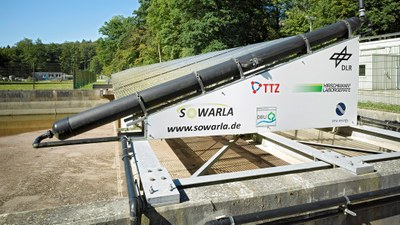HYDROGENIUM
The HYDROGENIUM lighthouse project combines the activities of several regional institutes and industry stakeholders. Its aim is to promote the expansion of a green hydrogen economy in the Heilbronn-Franken region.

DLR/Thomas Ernsting
With the development of the Ariane 5 launch vehicle, hydrogen became an important fuel in European space flight. Since then, DLR Lampoldshausen has been one of the largest users of hydrogen in Europe and has gained extensive expertise in handling large quantities of liquid hydrogen through its engine tests. In the future, hydrogen will also play a decisive role as an energy source at DLR. To this end, DLR, together with ZEAG Energie AG, has initiated a demonstration and research platform H2ORIZON, which makes it possible to produce and store hydrogen from renewable sources and use it in the areas of mobility, test bench facilities and energy supply with heat and electricity. The facility forms the cornerstone for the expansion of hydrogen activities at the DLR Institute of Space Propulsion. The two projects Zero Emission – Hydrogen Site Lampoldshausen and HYDROGENIUM were developed on this basis.

Before the liquid chemical space propulsion systems were used in the European Ariane launch vehicle, engineers at the DLR Institute of Space Propulsion were also researching methods for the efficient combustion of fossil fuels, especially crude oil. In 1977, they developed a rocket burner with significantly reduced soot and pollutant emissions. It soon became clear that this could be used not only in space flight, but also in heating systems in private households. In the boilers commonly used until then, the heating oil was atomized and mixed with air before combustion. Soot formation was the result. The new oil burner vaporized the oil mist at the atomizer nozzle. This increased the efficiency of the burner and significantly reduced soot formation and pollutant emissions.

Using the solar wastewater treatment plant (SOWARLA) – a system developed by DLR together with industrial partners – some of the wastewater at DLR Lampoldshausen can also be purified using sunlight. The water is pumped through special glass tubes until the pollutants are broken down with the help of solar energy and photocatalysts. The centerpiece is a solar receiver developed by Hirschmann Laborgeräte from Eberstadt: tubes made of robust and particularly transparent special glass. The advantage: solar radiation, and not electrically generated UV radiation as in comparable systems, provides the process energy for cracking the pollutants and can also supply the electrical energy for operating the entire system. In the Lampoldshausen plant, non-degradable compounds are removed from the cooling water used for testing the rocket engines. With SOWARLA, over 13,500 liters of water per day can be treated so that it can then be discharged into the nearby Buchsbach or reused at the site. In 2008, the DLR project for solar water purification was awarded the "Energy Globe" in Brussels, a globally important environmental prize.
The Technology Transfer Center (TTZ) forms the interface between research and industry. With access to DLR's extensive know-how, regional commercial enterprises can benefit from innovative and market-oriented space technologies.
It is the pioneering company of the TTZ, and for its employees, the name says it all: brandschutz.org. Owner Bernd Prümer's team tackles completely different "hot" things on the site where rocket engines are tested – such as fire protection systems. The company has developed a technology that prevents drainage channels in multi-storey buildings from turning into veritable fire chimneys in the event of a fire, through which a fire can "eat its way up" to the next floor up. Brandschutz.org has also developed a system that controls the ventilation of road and railroad tunnels – reliably, even in the event of a fire.
